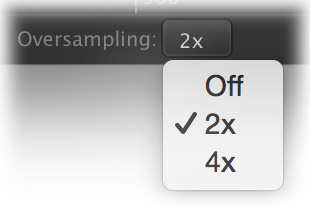FabFilter Pro-MB online help
Table of contents
Go to sectionFabFilter Pro-MB Help
Introduction
Using FabFilter Pro-MB
Full Screen mode, resizing and scaling
Presets
Purchasing FabFilter Pro-MB
Support
Oversampling
The dynamics algorithms often need to make very quick changes to the audio when compressing or expanding. These sudden changes can introduce a small amount of aliasing, which causes distortion and generally reduces the quality of the audio signal.

Oversampling is a way to reduce that aliasing by running the internal process at a sample rate that is two or four times higher than the host's sample rate. Additionally, this will also improve the frequency/phase response for high frequencies (near the Nyquist frequency at half the sample rate) in the Dynamic Phase and Minimum Phase processing modes.
When should I use oversampling?
You need it more when the compression or expansion is more aggressive and apparent. Usually, this is the case when using lower Attack and Release and/or higher Ratio and Range settings.
Of course, in return for a reduction of possible aliasing/distortion, the plug-in will use more CPU power when using oversampling. In addition, oversampling introduces a small latency, in addition to any processing mode or lookahead latency.
Tips
- Do you want to use zero-latency processing? Disable oversampling and lookahead in the bottom bar, and use either Dynamic Phase or Minimum Phase processing.
Next: Full screen mode, resizing and scaling
See Also
Overview
Processing mode
